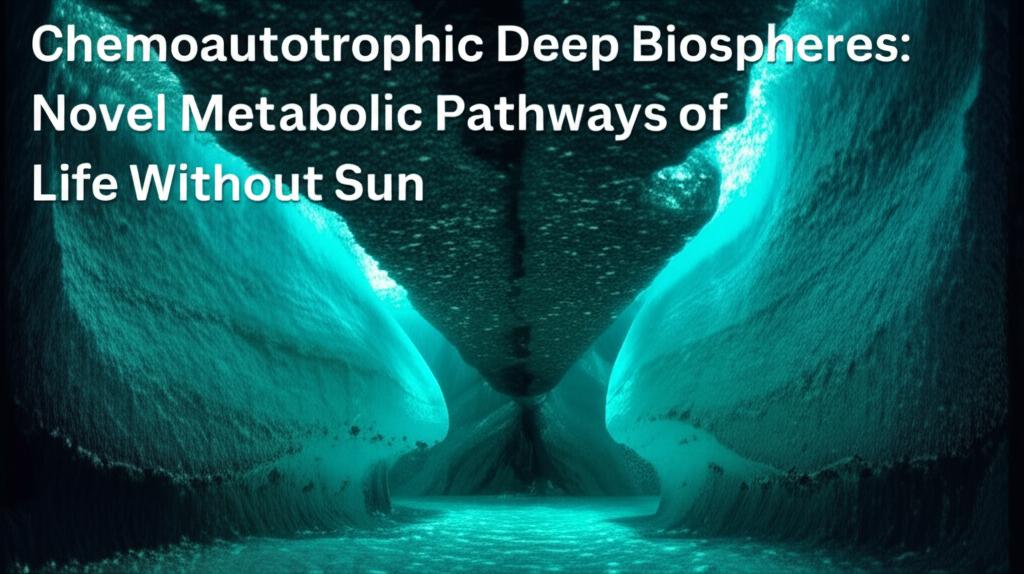Journey to the dark, crushing depths of our planet, and you'll find bustling ecosystems where sunlight is a forgotten myth. Here, in the deep biospheres – from volcanic hydrothermal vents to the hidden fractures within Earth's crust – life thrives on a completely different energetic principle: chemosynthesis. Instead of harnessing light, remarkable microorganisms, the chemoautotrophs, orchestrate a symphony of chemical reactions, transforming inorganic compounds into the building blocks of life. Recent discoveries are continually unveiling the ingenious and often bizarre metabolic pathways these extremophiles employ, rewriting our understanding of life's limits and possibilities.
One of the most electrifying recent revelations comes from the volcanic cavities hidden beneath hydrothermal vents. For decades, scientists studied the vibrant communities clinging to the exterior of these deep-sea chimneys, teeming with tubeworms and other unique creatures. But in a groundbreaking discovery, researchers ventured underneath the volcanic crust, uncovering a whole new dimension to these ecosystems. Cave systems, alive with worms, snails, and chemosynthetic bacteria, were found thriving in the warm (around 25°C or 75°F) vent fluids circulating below the seafloor. This suggests that vent habitats are two-tiered, with life flourishing both above and within the earth's crust, interconnected by the flow of these life-giving fluids. Intriguingly, this subsurface realm might also serve as a dispersal route for vent animals like tubeworms, explaining how they colonize new vent sites across the vast, dark expanse of the ocean floor.
The metabolic wizardry of these deep-dwelling microbes is truly astounding. They are the primary producers in these lightless worlds, forming the base of the food web. Instead of photosynthesis, they utilize chemical energy from compounds like hydrogen sulfide, methane, hydrogen gas, ferrous iron, and ammonia spewing from the vents or present in the deep subsurface. Many of these microbes engage in complex symbiotic relationships with larger organisms. For instance, giant tube worms, iconic inhabitants of hydrothermal vents, lack a digestive system and instead host chemosynthetic bacteria within their bodies. These bacteria convert chemicals from the vent fluid into organic matter, directly nourishing their hosts. Recent genomic studies on deep-sea clams and their symbiotic bacteria have even revealed instances of horizontal gene transfer – where genes are passed from the bacteria to the clam – a fascinating evolutionary adaptation that helps the clams thrive in these extreme environments.
Beyond the vents, the deep terrestrial subsurface – pores and fractures within rocks far beneath our feet – also harbors a vast and diverse microbial world. Here, life operates under extreme energy limitation, often near the thermodynamic limit of what's possible. Hydrogen gas (H₂), produced through processes like the radiolysis of water (water molecules split by natural radiation) and serpentinization (rock-water interactions), is a common and crucial energy source. Microorganisms in these environments have evolved sophisticated ways to harness this H₂, often through pathways like the Wood-Ljungdahl (reductive acetyl-CoA) pathway, which is particularly efficient in low-energy settings. This pathway allows them not only to fix inorganic carbon into biomass but also to generate energy.
Scientists are also uncovering intricate metabolic handoffs, or syntrophy, where different microbial species work together to perform complex chemical transformations that none could achieve alone. For example, some communities exhibit a "cryptic carbon cycle" where methane produced by one microbe (a methanogen) is consumed by another (an anaerobic methanotroph), which in turn releases carbon dioxide that the methanogen can use. There's even evidence suggesting direct electron sharing between different types of microbes through nanowire-like structures.
Recent research has also highlighted the importance of formate as an energy source in certain CO₂-limited deep subsurface environments, showcasing the adaptability of these microbial communities to specific geochemical conditions. Metagenomic studies – analyzing the collective genetic material from these environments – are constantly revealing novel microbial lineages and metabolic capabilities, painting a picture of a biosphere far more diverse and complex than previously imagined. Some studies are even employing proteotyping, analyzing protein fragments, to identify new extremophiles, which can be more accurate than traditional genetic methods for closely related species. This technique has already led to the identification of potentially new hardy bacteria in high-altitude lakes, environments that share similarities with early Mars.
The discovery of "single-species ecosystems," like the one found deep in a South African gold mine dominated by Candidatus Desulforudis audaxviator, further underscores the remarkable self-sufficiency of some deep life. This bacterium derives all it needs from the chemical products of water radiolysis, independently performing sulfate reduction, nitrogen fixation, and carbon fixation.
These ongoing explorations into chemoautotrophic deep biospheres are not just about cataloging new species or pathways. They offer profound insights into the fundamental nature of life, its adaptability, and its potential to exist in environments previously considered inhospitable, both on Earth and potentially elsewhere in the universe. The novel metabolic strategies uncovered in these dark realms continually expand our understanding of biogeochemical cycles and the very definition of what it means to be alive.

